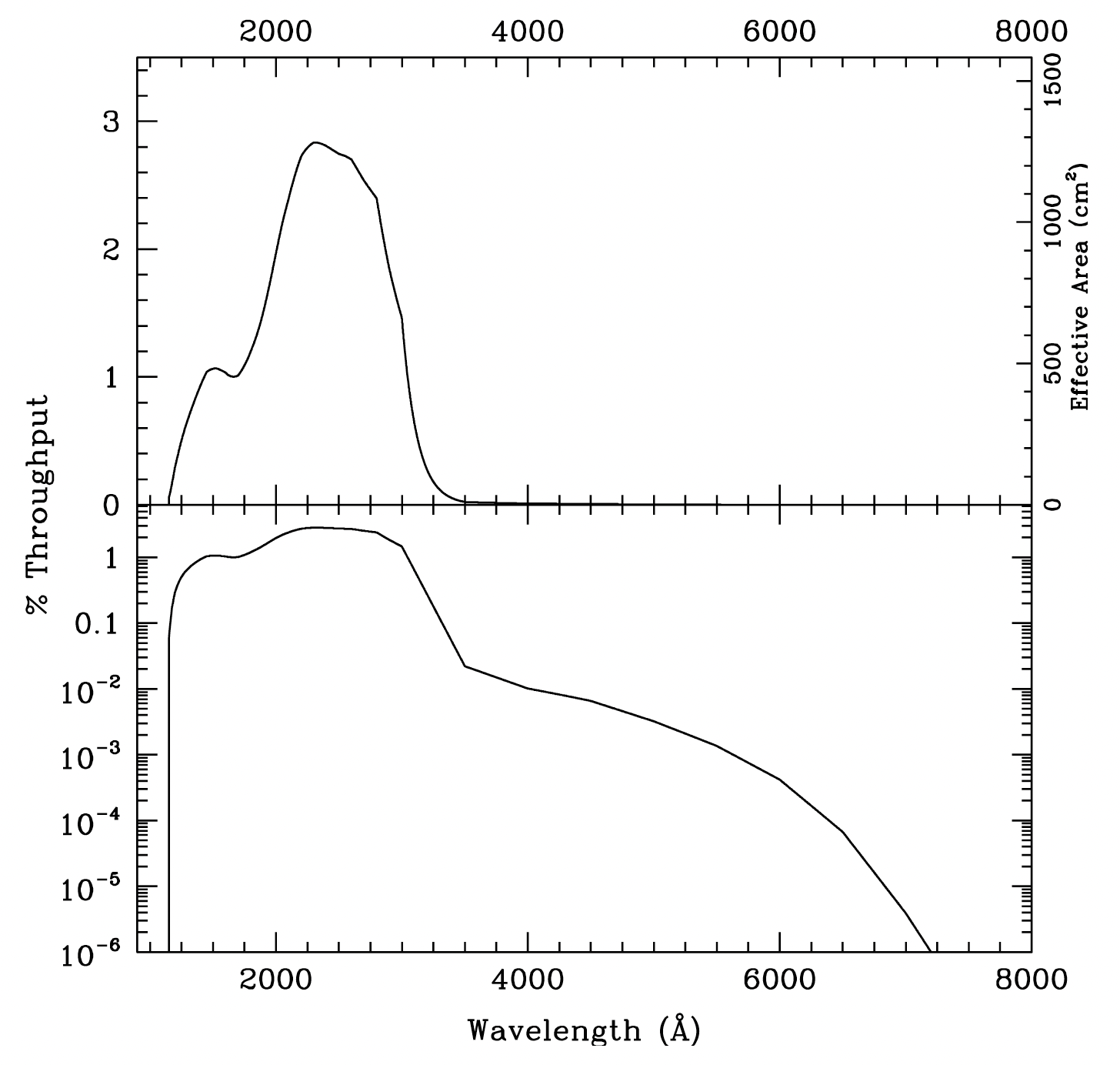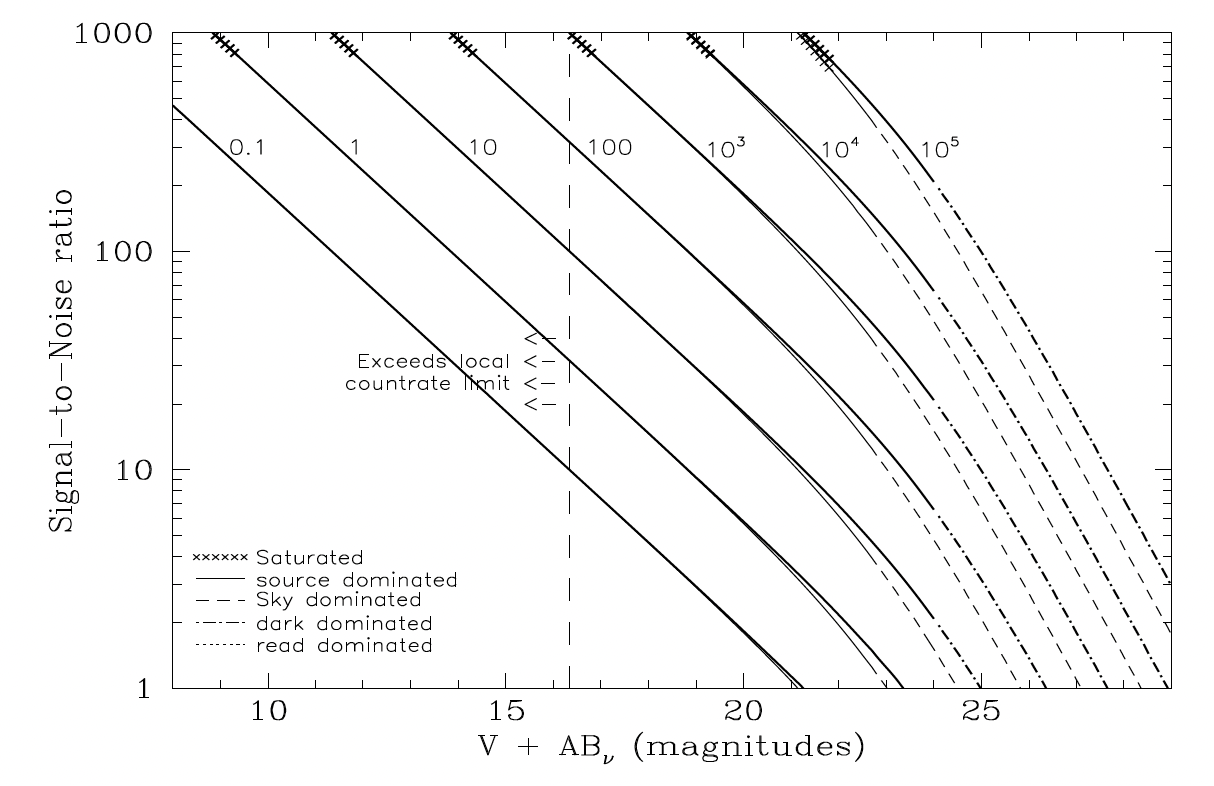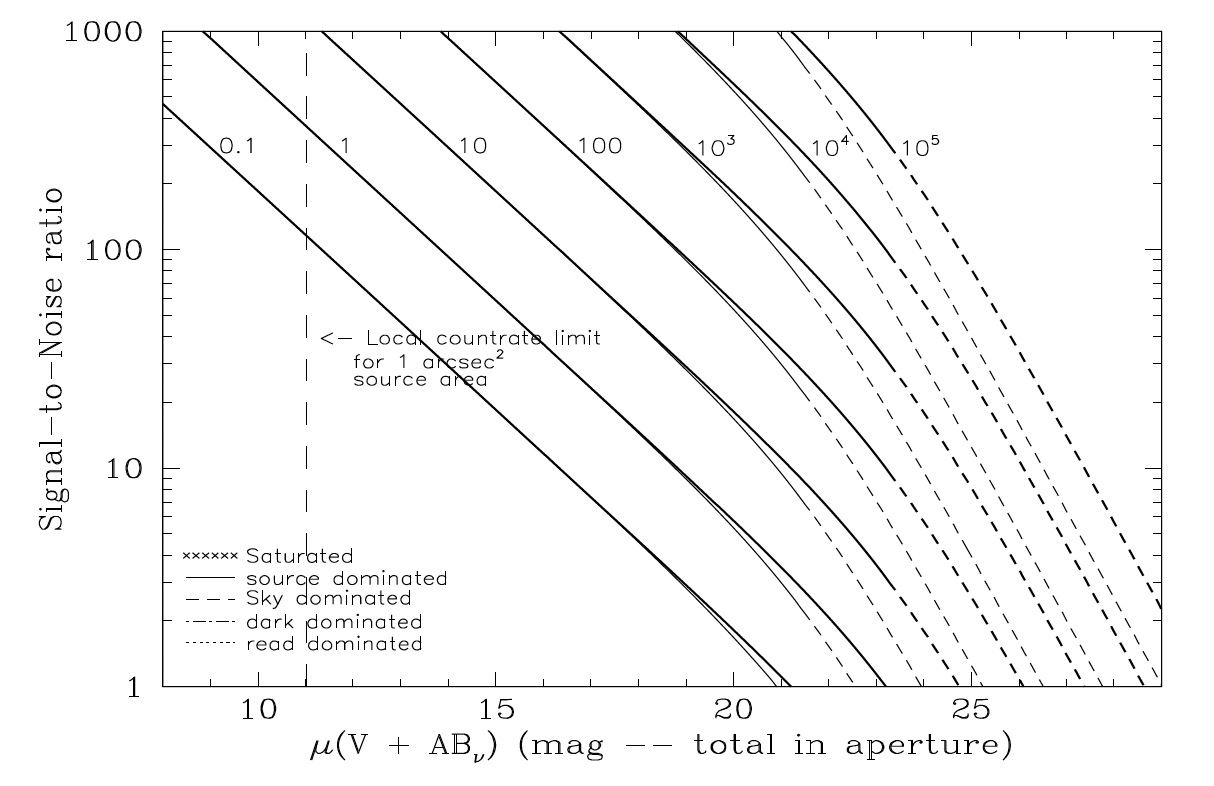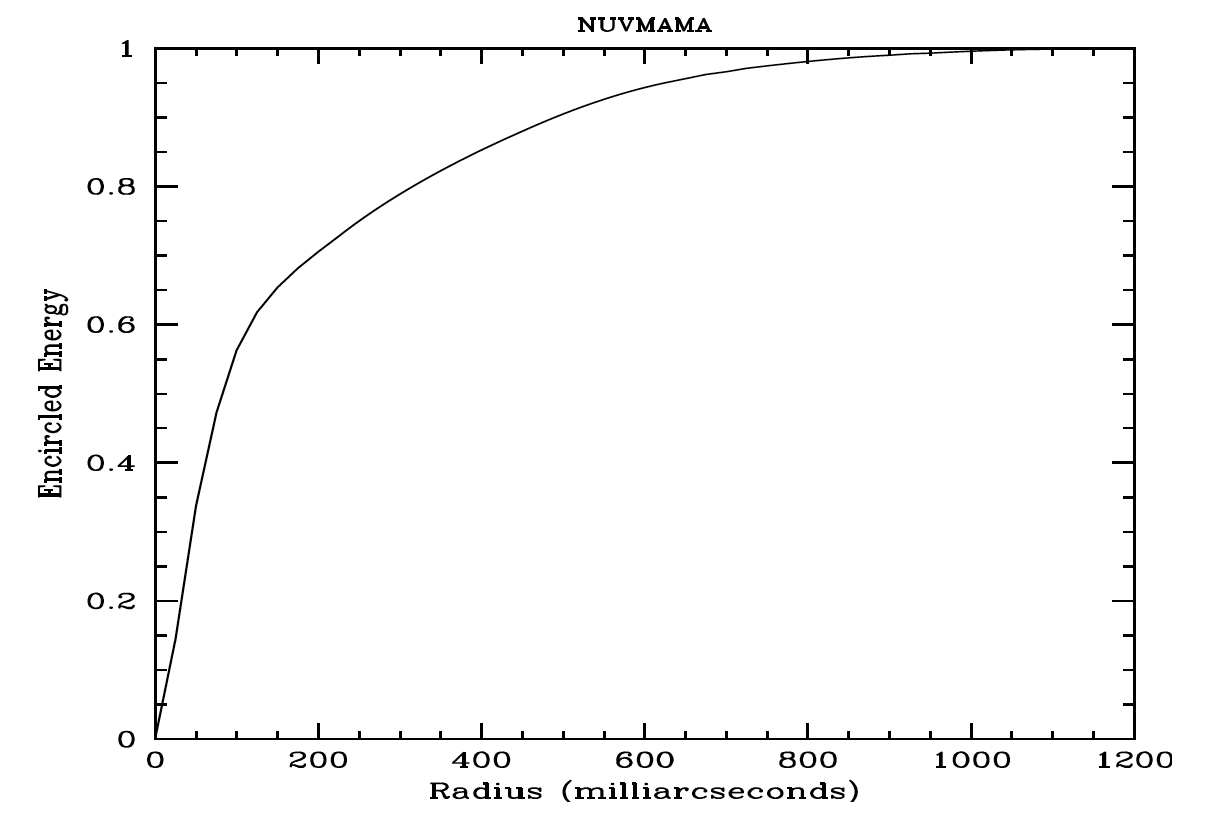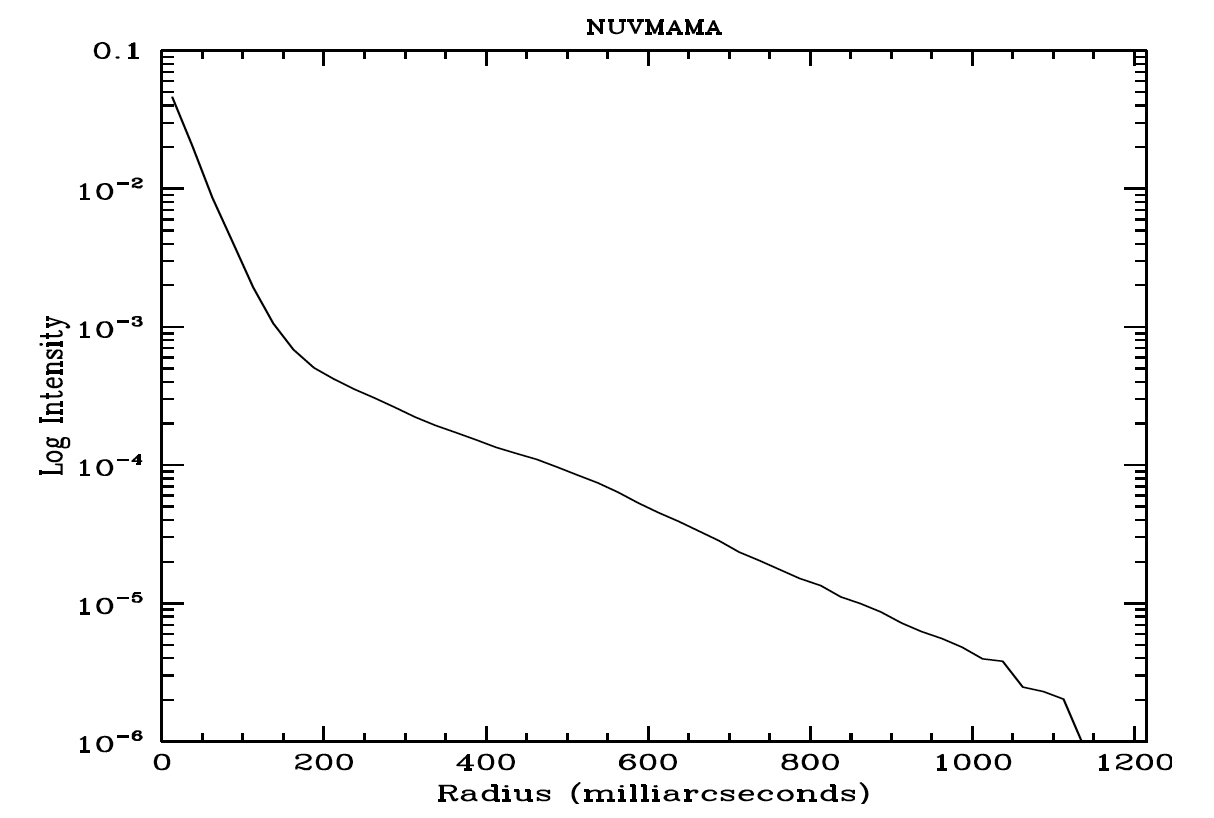25MAMA - NUV-MAMA, Clear
Description
The 25MAMA mode with the NUV-MAMA provides high-throughput broad-band near-ultraviolet (NUV) imaging with excellent pixel sampling and very high throughput at ~2500 Å.
Recommended Uses
This filter is available for broad-band NUV imaging, but not recommended; see below.
Special Considerations
NUV-MAMA clear images are marginally defocused because the mirror optimally focuses for use of a filter. Whenever possible, use F25SRF2 or F25QTZ instead of 25MAMA for NUV-MAMA imaging.
For long exposures of faint targets, sky background is likely to be a limiting factor. Observers should consider the use of DARKTIME or (preferably) use the F25QTZ filter, which has nearly the same throughput but rejects geocoronal Lyman-α and O I 1302 Å triplet air glow.
Users should also consider whether WFC3 with the F225W, the F300X or the F275W filters might be a better choice for their science goals.
Pivot λ (Å) | FWHM (Å) | AB mag zero point | Speak | Bλ | R80 (arcsec) | Flux in central pixel |
2260.6 | 1209.1 | 23.994 | 1.60e+14 | 1162.5 | 0.32 | 8% |
Table 14.10: 25MAMA NUV-MAMA Sensitivity & Throughput
λ | Sensitivity | % Throughput |
1200. | 7.83E12 | 0.29 |
1300. | 1.96E13 | 0.66 |
1400. | 2.96E13 | 0.93 |
1500. | 3.62E13 | 1.06 |
1600. | 3.76E13 | 1.03 |
1700. | 3.98E13 | 1.03 |
1800. | 4.93E13 | 1.20 |
1900. | 6.57E13 | 1.52 |
2000. | 8.95E13 | 1.96 |
2100. | 1.14E14 | 2.39 |
2200. | 1.36E14 | 2.71 |
2300. | 1.48E14 | 2.82 |
2400. | 1.53E14 | 2.81 |
2500. | 1.57E14 | 2.75 |
2600. | 1.59E14 | 2.69 |
2700. | 1.56E14 | 2.54 |
2800. | 1.49E14 | 2.34 |
2900. | 1.23E14 | 1.86 |
3000. | 9.38E13 | 1.37 |
3100. | 4.61E13 | 0.65 |
Table 14.11: Radial Profile for 25MAMA*
Radius | Fraction of Energy Encircled | ||
Pixels | Arcsec | Intensity | |
1 | 0.024 | 3.267e-02 | 0.141 |
1.5 | 0.037 | 2.107e-02 | 0.236 |
2 | 0.049 | 1.345e-02 | 0.331 |
3 | 0.073 | 6.141e-03 | 0.467 |
4 | 0.098 | 2.981e-03 | 0.557 |
5 | 0.122 | 1.485e-03 | 0.614 |
10 | 0.245 | 3.377e-04 | 0.746 |
15 | 0.367 | 1.676e-04 | 0.834 |
20 | 0.490 | 9.542e-05 | 0.900 |
25 | 0.613 | 4.543e-05 | 0.947 |
30 | 0.735 | 2.065e-05 | 0.972 |
40 | 0.980 | 5.088e-06 | 0.994 |
*See STIS ISR 2003-01.
-
STIS Instrument Handbook
- • Acknowledgments
- Chapter 1: Introduction
-
Chapter 2: Special Considerations for Cycle 33
- • 2.1 Impacts of Reduced Gyro Mode on Planning Observations
- • 2.2 STIS Performance Changes Pre- and Post-SM4
- • 2.3 New Capabilities for Cycle 33
- • 2.4 Use of Available-but-Unsupported Capabilities
- • 2.5 Choosing Between COS and STIS
- • 2.6 Scheduling Efficiency and Visit Orbit Limits
- • 2.7 MAMA Scheduling Policies
- • 2.8 Prime and Parallel Observing: MAMA Bright-Object Constraints
- • 2.9 STIS Snapshot Program Policies
- Chapter 3: STIS Capabilities, Design, Operations, and Observations
- Chapter 4: Spectroscopy
- Chapter 5: Imaging
- Chapter 6: Exposure Time Calculations
- Chapter 7: Feasibility and Detector Performance
-
Chapter 8: Target Acquisition
- • 8.1 Introduction
- • 8.2 STIS Onboard CCD Target Acquisitions - ACQ
- • 8.3 Onboard Target Acquisition Peakups - ACQ PEAK
- • 8.4 Determining Coordinates in the International Celestial Reference System (ICRS) Reference Frame
- • 8.5 Acquisition Examples
- • 8.6 STIS Post-Observation Target Acquisition Analysis
- Chapter 9: Overheads and Orbit-Time Determination
- Chapter 10: Summary and Checklist
- Chapter 11: Data Taking
-
Chapter 12: Special Uses of STIS
- • 12.1 Slitless First-Order Spectroscopy
- • 12.2 Long-Slit Echelle Spectroscopy
- • 12.3 Time-Resolved Observations
- • 12.4 Observing Too-Bright Objects with STIS
- • 12.5 High Signal-to-Noise Ratio Observations
- • 12.6 Improving the Sampling of the Line Spread Function
- • 12.7 Considerations for Observing Planetary Targets
- • 12.8 Special Considerations for Extended Targets
- • 12.9 Parallel Observing with STIS
- • 12.10 Coronagraphic Spectroscopy
- • 12.11 Coronagraphic Imaging - 50CORON
- • 12.12 Spatial Scans with the STIS CCD
-
Chapter 13: Spectroscopic Reference Material
- • 13.1 Introduction
- • 13.2 Using the Information in this Chapter
-
13.3 Gratings
- • First-Order Grating G750L
- • First-Order Grating G750M
- • First-Order Grating G430L
- • First-Order Grating G430M
- • First-Order Grating G230LB
- • Comparison of G230LB and G230L
- • First-Order Grating G230MB
- • Comparison of G230MB and G230M
- • First-Order Grating G230L
- • First-Order Grating G230M
- • First-Order Grating G140L
- • First-Order Grating G140M
- • Echelle Grating E230M
- • Echelle Grating E230H
- • Echelle Grating E140M
- • Echelle Grating E140H
- • PRISM
- • PRISM Wavelength Relationship
-
13.4 Apertures
- • 52X0.05 Aperture
- • 52X0.05E1 and 52X0.05D1 Pseudo-Apertures
- • 52X0.1 Aperture
- • 52X0.1E1 and 52X0.1D1 Pseudo-Apertures
- • 52X0.2 Aperture
- • 52X0.2E1, 52X0.2E2, and 52X0.2D1 Pseudo-Apertures
- • 52X0.5 Aperture
- • 52X0.5E1, 52X0.5E2, and 52X0.5D1 Pseudo-Apertures
- • 52X2 Aperture
- • 52X2E1, 52X2E2, and 52X2D1 Pseudo-Apertures
- • 52X0.2F1 Aperture
- • 0.2X0.06 Aperture
- • 0.2X0.2 Aperture
- • 0.2X0.09 Aperture
- • 6X0.2 Aperture
- • 0.1X0.03 Aperture
- • FP-SPLIT Slits 0.2X0.06FP(A-E) Apertures
- • FP-SPLIT Slits 0.2X0.2FP(A-E) Apertures
- • 31X0.05ND(A-C) Apertures
- • 0.2X0.05ND Aperture
- • 0.3X0.05ND Aperture
- • F25NDQ Aperture
- 13.5 Spatial Profiles
- 13.6 Line Spread Functions
- • 13.7 Spectral Purity, Order Confusion, and Peculiarities
- • 13.8 MAMA Spectroscopic Bright Object Limits
-
Chapter 14: Imaging Reference Material
- • 14.1 Introduction
- • 14.2 Using the Information in this Chapter
- 14.3 CCD
- 14.4 NUV-MAMA
-
14.5 FUV-MAMA
- • 25MAMA - FUV-MAMA, Clear
- • 25MAMAD1 - FUV-MAMA Pseudo-Aperture
- • F25ND3 - FUV-MAMA
- • F25ND5 - FUV-MAMA
- • F25NDQ - FUV-MAMA
- • F25QTZ - FUV-MAMA, Longpass
- • F25QTZD1 - FUV-MAMA, Longpass Pseudo-Aperture
- • F25SRF2 - FUV-MAMA, Longpass
- • F25SRF2D1 - FUV-MAMA, Longpass Pseudo-Aperture
- • F25LYA - FUV-MAMA, Lyman-alpha
- • 14.6 Image Mode Geometric Distortion
- • 14.7 Spatial Dependence of the STIS PSF
- • 14.8 MAMA Imaging Bright Object Limits
- Chapter 15: Overview of Pipeline Calibration
- Chapter 16: Accuracies
-
Chapter 17: Calibration Status and Plans
- • 17.1 Introduction
- • 17.2 Ground Testing and Calibration
- • 17.3 STIS Installation and Verification (SMOV2)
- • 17.4 Cycle 7 Calibration
- • 17.5 Cycle 8 Calibration
- • 17.6 Cycle 9 Calibration
- • 17.7 Cycle 10 Calibration
- • 17.8 Cycle 11 Calibration
- • 17.9 Cycle 12 Calibration
- • 17.10 SM4 and SMOV4 Calibration
- • 17.11 Cycle 17 Calibration Plan
- • 17.12 Cycle 18 Calibration Plan
- • 17.13 Cycle 19 Calibration Plan
- • 17.14 Cycle 20 Calibration Plan
- • 17.15 Cycle 21 Calibration Plan
- • 17.16 Cycle 22 Calibration Plan
- • 17.17 Cycle 23 Calibration Plan
- • 17.18 Cycle 24 Calibration Plan
- • 17.19 Cycle 25 Calibration Plan
- • 17.20 Cycle 26 Calibration Plan
- • 17.21 Cycle 27 Calibration Plan
- • 17.22 Cycle 28 Calibration Plan
- • 17.23 Cycle 29 Calibration Plan
- • 17.24 Cycle 30 Calibration Plan
- • 17.25 Cycle 31 Calibration Plan
- • 17.26 Cycle 32 Calibration Plan
- Appendix A: Available-But-Unsupported Spectroscopic Capabilities
- • Glossary
